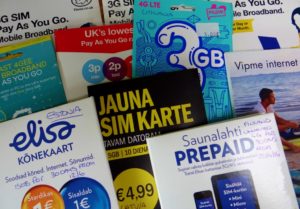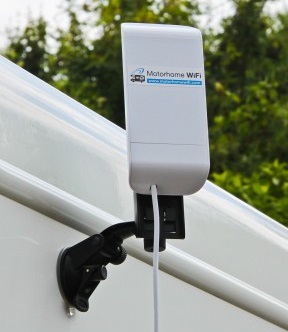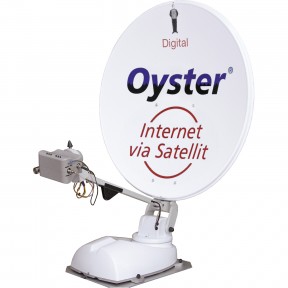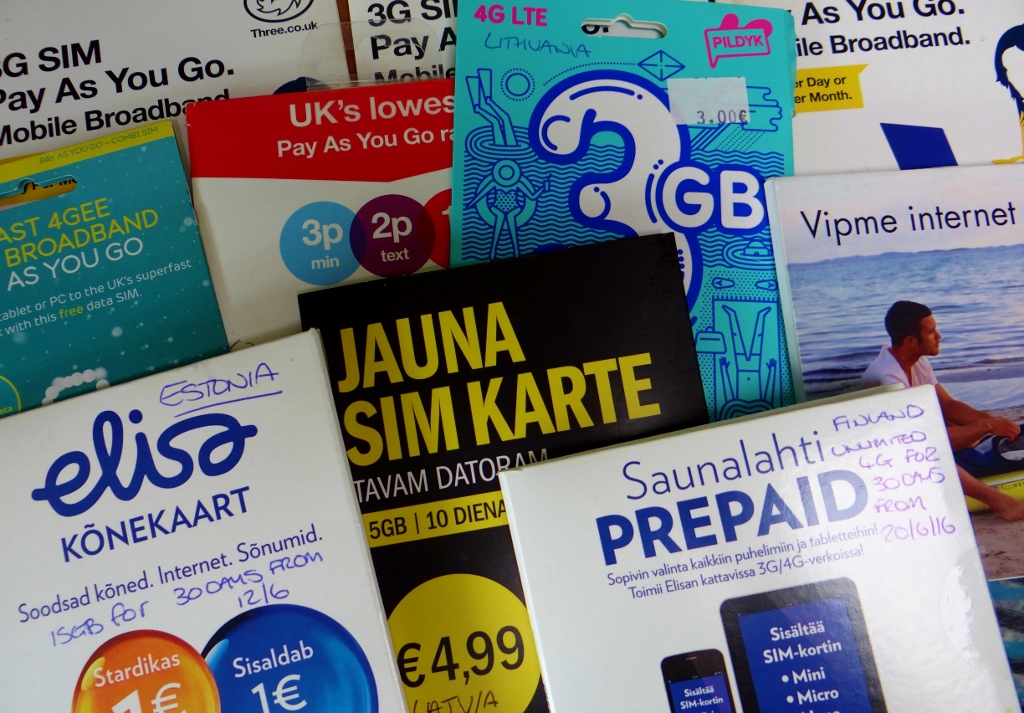6 Tips for Roaming European Internet Access 2016

The SIMs we’ve used so far in 2016
Fancy roaming about Europe in a motorhome or camper van, footloose and fancy free? Don’t blame you, it’s a pretty cool continent to amble about.
All in, we’ve had the good fortune to spend 30 months doing just that, including a couple of forays to North Africa. We’ve updated this blog from everywhere we’ve gone to. That’s about 30 countries, and over 600 places (so far), so we’ve built up a bit of knowledge on how to obtain and use SIM cards and WiFi abroad.
Here’s are 6 tips to keep you connected, hopefully save you some trouble and pop some hard-earned back into your pocket!
Tip 1: Suss Out Your Internet Strategy
If you’re planning on visiting France, staying on campsites and just using email to stay in touch with friends and family back home, you’ll likely want a different Internet solution to someone running a time-critical business from the road, roaming from country to country each week. Here are a few example strategies, depending on how much you want to spend, the speed of the Internet connection you need and when/where you need it:
Strategy 1: Low Cost, Low Convenience: If you’re not bothered about being able to connect all the time from the comfort of your van, and want to keep costs to a minimum, just look for WiFi on campsites, Tourist Info offices, cafés, in town centres and the like. You might need to sit in reception, or park your van close to wherever an access point has been mounted, in order to get a decent connection. Also be aware that campsite WiFi can be costly, slow or simply fail completely: we once had to argue to get our money back after the site WiFi in Rome failed for three days.
Strategy 2: Low Cost, Medium Convenience: If you want to be able to sit in your van and use the Internet, but aren’t much bothered about being able to access it every day, and want to keep connection costs down, then WiFi is a good option, but consider buying a signal booster. These work. We have a uni-directional one which can pick up signals from huge distances but is less convenient than an omni-directional one, which generally have a shorter range. With a uni-directional antenna you have to point it in the direction of the network, which isn’t always easy if you don’t know where it is. Check out motorhomewifi.com for WiFi boosters. Be aware that these boosters only help you get a good connection to a WiFi network; if the connection from the campsite out to the Internet is slow or overloaded, then you’ll still have a poor experience.

A uni-directional WiFi signal booster from motorhomewifi.com. We met one couple who’d mounted such an antenna on the back of their TV satellite dish, so it could be lifted up and rotated from inside the van.
Strategy 3: Medium Cost, Medium to High Convenience: If you want to be able to connect from your van all the time, but don’t want to install a £3000+ satellite Internet system, then cellular (3G or 4G) is probably for you. The days of slow (GPRS or EDGE) connections are over, 3G and 4G mobile networks are nigh-on everywhere. Ignore any satellite marketing material which claims otherwise.
We used to use a USB dongle connected to a laptop, but in order to use the Internet connection on other devices (phone, ipad) the laptop had to be running, and some software like Connectify installed and running to share the network out – not very convenient. We now use a MiFi-type device (cost: about £90 for a 4G one) to share out the connection, the SIM card fits straight into the MiFi and broadcasts the internet connection into our van, like a mini WiFi network. Our MiFi is connected to our 12v system for power and also to a roof-mounted 4G antenna (cost: about £150) which we fitted ourselves, to maximise our chances of having a connection. Having used the antenna for 6 months we can confirm it works very well, although I suspect even it might struggle in Ksar Ghilane!
The SIM card needed to connect to the cellular network requires a subscription. The cost of this varies massively by provider, country and deals available at the time. As a very (very!) rough rule of thumb, if you budget for about £250 a year for 5GB per month of data you should have cash left at the end of the year after wandering umpteen European countries, especially if you use local SIMs (see below).
In terms of speed, 3G speeds (minimum 1Mbps or more download, 0.5Mbps upload) are typical in most countries now, even outside towns and cities. This makes most services (except decent streaming video perhaps) available to us consistently. 4G is becoming more and more available, which will usually support good video streaming. Skype recommend about 0.5Mbps download and upload, for high quality video calls, jumping to 1.5Mbps (down and up) for HD video.

I’ve just done a speed test on our 4G connection here in Finland (we’re by a beach, about 2km from the nearest town). 13Mbps down and 5.7Mbs up, so we can easily use Skype video calls or similar streaming services
Strategy 4: High Cost, High Convenience: Finally, if you want a solution which will connect just about everywhere, without worrying about crossing borders or how much data you’re using, get a roof-mounted auto-seeking unlimited data satellite Internet system. It’ll cost you £3000ish, plus £350ish a year subscription for such a system. You can get kits which combine TV and Internet. Cheaper ones (£1000ish) are available (like this) which might work well if you plan to stay on campsites and not move about much, since it’s a dish on a tripod. I’ve never used satellite Internet, so can only guess how good it is, but line of sight (not parking under trees, or by buildings), the current draw from leisure batteries, the latency involved (only important for real-time stuff like video calls) and the satellite footprint would probably feature in my thinking if I were to go down this route.

Roof-mounted motorhome satellite internet system – photo from motorhomewifi.com
Tip 2: Mix Up WiFi and Cellular
Unless you’re a very casual user of the Internet, you’re likely to get best value from a combination of cellular and WiFi. We’ve got a WiFi booster to enable us to pick up distant or weak WiFi networks (we have a fore-runner to this kit). We only tend to use it when we know there is WiFi available to us, such as when we’re on a campsite, or when we have no cellular access (typically when we’ve just crossed a border) and are willing to play hunt-the-WiFi. Unlocked WiFi is a fairly rare animal these days in most countries by the way. Having both methods available to us increases our flexibility, and means we can use streaming services like Skype more often (see below).
Tip 3: Get a Fall-Back Solution, a UK SIM
Our fall-back solution, which we can use if all else fails, is a pay-as-you-go roaming UK SIM. At the time of writing (June 2016) Three UK’s Feel at Home is about the most cost effective and convenient solution (we got our SIM from motorhomewifi.com, but you can also get them here from Amazon UK). It lets us access the Internet in numerous European countries (plus more further afield – full list here) without paying bonkers-high roaming charges, and it ‘just works’ as you go from country to country.
The downside? It’s normally not as cheap as local SIMs and you can only use each SIM for a limited length of time in ‘Feel at Home’ countries. You can’t just have one SIM and use it for months on end (check the latest terms and conditions – at the time of writing each SIM could only roam for 3 out of every 12 months). How much Three police this, we don’t know, so we’ve got a few Feel at Home SIMs that are Pay as You Go, not on a contract which means we get less data per month but enables us to rotate SIMs so we don’t fall foul of the 3 month rule. Also, Three’s SIM won’t work on the latest 4G networks abroad, only 3G or slower – although 3G’s fast enough for us almost all of the time.
We typically only use the Three SIM in Feel at Home countries, adding credit to it and using that to buy an ‘add-on’ which gives us a fixed amount of data to use over 30 days. However, the Three SIM will also work in non Feel at Home countries like Germany by roaming. This is far too expensive to use normally (about £44 per GB), but in an emergency will get us online.e
A few other things to note:
- If convenience is more important to you than cost, check out http://www.bitebird.com. Bitebird is basically a MiFi type device with a SIM which works in a large number of countries, but doesn’t charge at roaming rates. It’s not as cheap as local SIMs or Three’s Feel at Home, but might work for you depending on the countries you plan to visit and how long you will stay in them.
- Make sure the SIM is enabled for roaming with your provider.
- Make sure your MiFi, phone, tablet or dongle has the ‘allow roaming’ option ticked.
- If you want to share the SIM connection with your laptop etc (tethering), check the provider allows this before you buy the SIM.
- If you want to be able to use local SIMs, make sure your phone/MiFi etc is unlocked, so it will work with SIM cards from other networks.
- Ideally before you leave home, check how to buy credit for your SIM. You may find it easier to buy vouchers in the UK, but be aware these may have expiry dates.
Tip 4: Don’t Overdo It, Track Your Data Use
It’s hard to work out just how much data you’ll use when deciding on which cellular SIM or package to get. If you’re thinking of using streaming-type services like viewabroad.com, FaceTime, Skype, YouTube or even Internet radio, then you’ll probably bust through any monthly data cap in no time. It’ll get expensive. The £250 mentioned above assumes you don’t go over your cap, if you do you’ll need to buy top-ups which could multiply that cost up in no time (viewabroad.com uses roughly 4MB per minute, 0.25GB an hour).
The answer to this, if you’re bothered about the cost, is to either get an unlimited SIM package (and even those are normally limited by fair use policies), or to carefully track the data you use and only use streaming services when you have WiFi. Unlimited packages aren’t normally available or cost too much for us, so we track our use using the metering feature available on our MiFi.
MiFi Data Metering Screen – the data used is also conveniently shown on the front of the MiFi itself
Tip 5: Look for Local SIMs
As a rule, local SIMs will be cheaper than using a roaming SIM. We’ve bought pre-paid (no contract) local SIMs in over ten countries now, and have always been able to get one without a local address or credit card. We’re currently using a local SIM in Finland, on the 4G Elisa network, which cost us £20 for the SIM and a month’s ‘unlimited’ data (which means up to 3GB a day – loads more than we normally use).
If you do intend to use local SIMs, here are a new extra tips:
- This website is excellent for details on prepaid SIM deals across the world, we’ve found it really helpful to consult before trying to get a local SIM.
- The language barrier is the hardest part about getting a SIM. In the larger phone shops someone might speak English, but we have often had to queue for a long time to be served. In some countries you can buy SIMs from a supermarket or kiosk, but the assistant is less likely to speak English. We take a SIM card with us and point at it, this helps to make us understood. Also, if you use Google Translate to get a phrase like ‘Do you have prepaid Internet data cards please?’ onto a note on your phone, you can show it to the person and take it from there.
- Some SIMs need to be put into a phone to be activated. Try and get one with English instructions so you know how to do it. You might need to ‘phone’ a certain number – although you don’t actually speak to anyone, this simply activates the card.
- You may need to unlock each SIM on first use. The four digit PIN number needed is usually on the credit card-sized piece of plastic the SIM comes in, and is frequently 1234!
- Some SIMs are valid for a time duration – a week, ten or 30 days for example. If you don’t use the data in that time, you lose it. Others are valid per day used, so if you don’t use it one day, then you don’t pay for that day. Check the details for whichever package you’re buying.
- Some SIMs need you to buy credit before they’ll work. Use the website above to try and suss this out, and again any English instructions with the card will help.
- When you buy credit, you may need to tell the network which package you want. This may be either by a text message to a certain number, or call a package-dependent number. For example, €10 worth of credit might need converting to a 5GB/30 day package by calling 6105000# or some such. If you don’t do this, the provider will assume you want your €10 used on a per MB of data used basis, which will give you much less than 5GB!
- Providers often send text messages to the SIM in the local language. You normally only need these when first setting the SIM up or buying more credit, and they’re usually just these to tell you things are working as they should (even if you can’t read them, you should be able to connect anyway). In some cases you can change the language to English by calling or texting a code; check the packaging or provider’s website.
- Some countries have really got the right idea with tourist SIMs. In Croatia we went to a Post Office, asked for a SIM in English and were given a pre-activated, pre-loaded SIM which gave us ten 1GB/24 hour periods for a few pounds. No passport, no contract, no need to activate, no need to buy a top-up. No need for Croatian language skills. Sorted.
- Check the physical size of SIM you need as some devices need a ‘cut down’ SIM. That said, the SIMs we’ve bought were pre-cut and could easily be ‘snapped’ down to smaller sizes by hand.
Tip 6: Avoid these Uncommon Mistakes
Here are a few less-than-common mistakes we have come across (which we might have made ourselves, I couldn’t possibly comment) when using SIM cards abroad:
- As you move around you may find 3G or 4G Internet slow or it might fail completely. This is unusual, especially with a roof-mounted antenna, but try manually selecting a different network (check the manual for your phone, MiFi, dongle, etc for how to do this), this has worked most of the time for us. We also found this happened once or twice with the Feel at Home SIM, but only when crossing an International border.
- Ask for, or look up, the APN when you get a new SIM – it is often on the packaging or the SIM deals website linked to above. This is a small line of text or a single word like ‘Internet’. Usually when you use the SIM for the first time the APN is automatically set, but if the SIM fails to work, you may need to check the APN has been set correctly.
- Again with the APN, if the SIM fails to connect try changing the APN setting from static to dynamic if this option is available. We’ve only ever needed to do this once.
- If the SIM still refuses to connect, or repeatedly disconnects after a minute or two, try changing the ‘auto’ setting for the network type (2G, 3G or 4G) to manual. This once worked for us when all else failed.
Sometimes you just have to suck it up. We bought a local SIM in Sicily once which should have lasted a month. After a couple of day’s sparing use it conked out. Back to the shop (a different one to the one we bought it in, as we’d shifted around the island). They explained a text message is sent to the SIM after two days, at which point you must follow the instructions in it before using the SIM any longer. With the SIM in a USB dongle, we didn’t see the SMS message so accidentally ate all the remaining credit in minutes. No-one explained this when we bought the SIM (no-one spoke English and we know no Italian to be fair), and no refund was forthcoming, just some sympathetic shrugs! You win some, you lose some.
Bonus Tip! Security
One point to consider when choosing whether to use WiFi or cellular: security. WiFi networks on the road aren’t controlled by you. That is, by their nature, they’re provided and shared by strangers. Some of those strangers might turn out to be villains. Even the owner of the network could be a bad lad. In this case, it is technically possible for them to do bad stuff to you: such as grabbing the usernames and passwords you pop into websites. I’ve never had this happen to me, and I can’t say I’ve heard of anyone affected by it, but we do tend to carry out sensitive stuff (paying tax, doing banking etc) on our cellular connection, which we feel is generally a safer method.
Phew! Hope some of this proves useful to someone, somewhere!
Cheers, Jay
Disclosure: motorhomewifi.com are mentioned numerous times in this article. We have no financial relationship with them, although they did gift us equipment in the past in return for reviewing it. My personal opinion is they know their stuff, and develop and sell systems which work very well, and are often unique to the motorhome and caravan market.




Top draw Jay, well done and thanks. Kindest… Wayne.
Brilliant review of the systems available! Lots of which we have found out, like you by trial and error – this should be a ‘must take’ for folks planning to motorhome or caravan in Europe.
Of course recent events could alter some legislation but no point worrying until we know where we stand :-(
Ann
Thanks Ann. Brexit might mean Britons miss out on the removal of roaming charges (or it might not, who knows?), but to be honest all it’ll do is increase the case further for local SIMs, which should (fingers crossed) continue to get cheaper and easier to buy and use. Cheers, Jay
That hits the spot ja. Nice one!
We also use Iboost and also a roof mounted mobile aerial from motorhome wifi. Always so helpful and great gear from them. People often say their stuff is dear but it’s good quality and so easy to set up. We’re using Iboost now to email this from sunny France.
What a comprehensive review…just what we were looking for as we leave New Zealand next week for UK, and our own motorhome for 5 months travelling Europe this year, and will return each year to do the same. Have been concerned about the best way to get internet, and this article covers EVERYTHING!!! We spent a total of 18 months over 5 years in USA doing the same thing and in our last trip got a Mifi from Verizon which covered most states and we topped up online. Once we are on the road will continue on with our travel blog http://www.ruakiwi.blogspot.com Many thanks for this. Meg
Glad it’s of use Meg, worth writing just to get a comment like yours, many thanks. Thanks for the blog too, we’ve got the US in our sights at some point so we’ll have a read through it (or at least some of it!) later on. Right, time to get on t’ road, more forest and lake to see! Cheers, Jay
Hi Jason,
when we travelled Europe last year we used a “3” data sim in our Huawei mifi, only to find out after we left the UK is was limited to 3G when not in the UK, looking at your pictures, you are using EE, and getting 4G in Europe, is that correct? I ask because we are coming back to do it all again in 2017, thanks
Raymond
Hi Raymond.
We used EE in the UK, never used it outside. You’re quite right, no 4G with Three outside the UK at the moment. It’s not been that important to us whether we have 3 or 4G so we’ve not looked into any decent roaming UK 4G SIMs.
Cheers, Jay
Interesting to hear you have your sights on the US.
We are currently in Oregan having travelled up from Arizona looking at buying a US motor home. At present Oregan looks favourable due to the state tax ruling. It is incredible what you can buy for your money here compared to England although this has changed this last week with the £ weakening against the dollar.
We met a French couple at the Hoover dam who shipped their MH over. I was interested to hear that it was not too expensive and that they were finding using their MH here in the states was okay. The only minor trouble they have is disposing of their black waste as the American MH have holding tanks that are pumped out.
Also at the dam I met a German man who had shipped his convertred lwb Land Rover over and was touring the states for 6months. He appeared to be having a great time.
We are continuing up the west coast into Canada to see what options there is there for buying a MH?
As a side note the Americans think we are completely crazy for voting out of the EU.
Hello!
Very usefull information. Last year we have had a very bad experiences with SIM card which we bought from Orange in France. When we install it , it keeps “saying” that the credit has expired. We went back to the shop, they “help” us, saying it’s Ok, but back at womo it doesn’t work again. As we were visiting our French friend he went with us back to the shop. To make the story short: we had to buy another one (30€ lost) but the whole story had the same end as the first one. So, dissapointed, we decided not to buy any SIM card at Orange. :( at least in France.
May I ask you what kind of SIM card you using now in Morocco and from which provider? Any other suggestion, maybe.
Wish you a nice travel,
Vesna
Hi Vesna. We’re on Maroc Telecom here in Morocco. There are other providers of course, but Maroc Telecom seems to have the most shops and the 3G service is usually good.